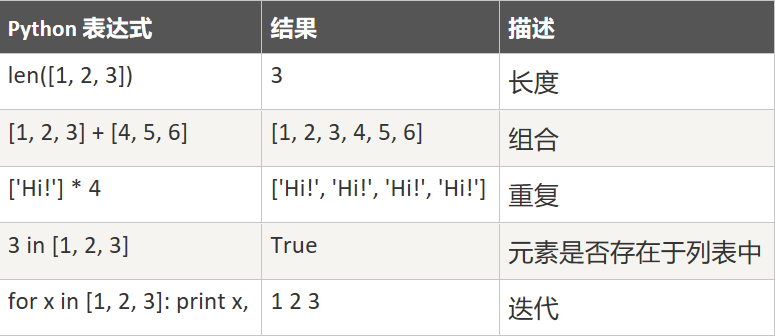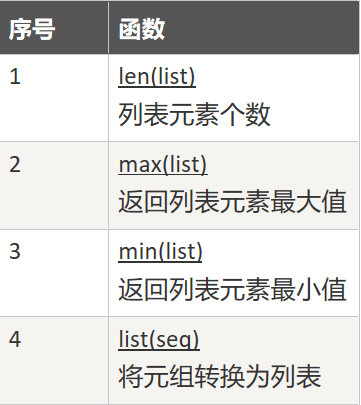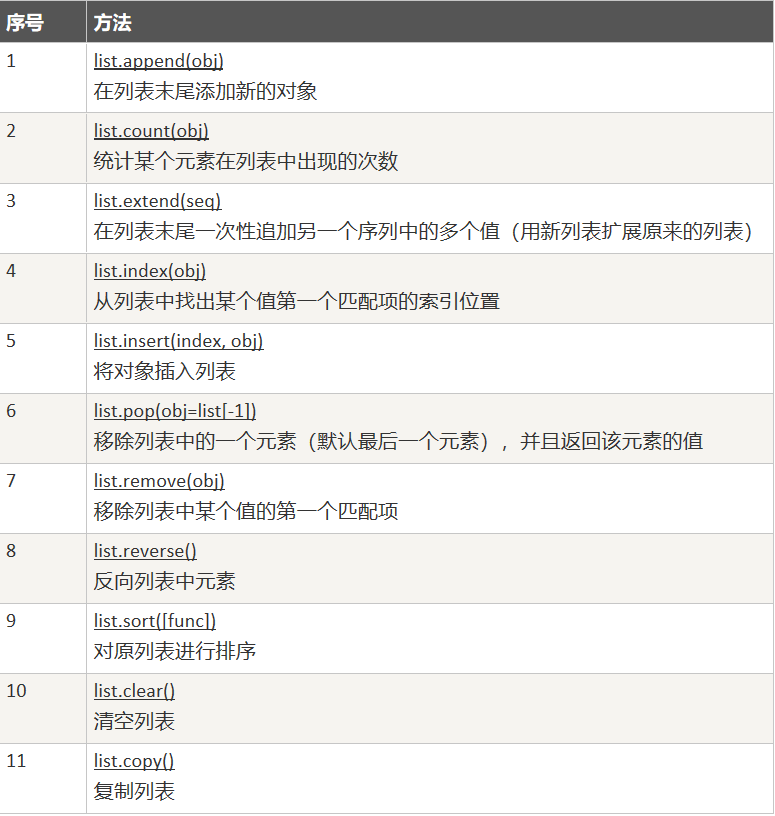序列是Python中最基本的数据结构。序列中的每个元素都分配一个数字 - 它的位置,或索引,第一个索引是0,第二个索引是1,依此类推。
Python有6个序列的内置类型,但最常见的是列表和元组。
序列都可以进行的操作包括索引,切片,加,乘,检查成员。
此外,Python已经内置确定序列的长度以及确定最大和最小的元素的方法。
列表是最常用的Python数据类型,它可以作为一个方括号内的逗号分隔值出现。
列表的数据项不需要具有相同的类型
创建一个列表,只要把逗号分隔的不同的数据项使用方括号括起来即可。如下所示:
list1 = ['Google', 'Runoob', 1997, 2000]; list2 = [1, 2, 3, 4, 5 ]; list3 = ["a", "b", "c", "d"];
与字符串的索引一样,列表索引从0开始。列表可以进行截取、组合等。
访问列表中的值
使用下标索引来访问列表中的值,同样你也可以使用方括号的形式截取字符,如下所示:
[root@localhost ~]# vi hello.py #!/usr/bin/python list1 = ['Google', 'Runoob', 1997, 2000]; list2 = [1, 2, 3, 4, 5, 6, 7 ]; print ("list1[0]: ", list1[0]) print ("list2[1:5]: ", list2[1:5]) [root@localhost ~]# ./hello.py list1[0]: Google list2[1:5]: [2, 3, 4, 5]
更新列表
你可以对列表的数据项进行修改或更新,你也可以使用append()方法来添加列表项,如下所示:
[root@localhost ~]# vi hello.py #!/usr/bin/python list = ['Google', 'Runoob', 1997, 2000] print ("第三个元素为 : ", list[2]) list[2] = 2001 print ("更新后的第三个元素为 : ", list[2]) [root@localhost ~]# ./hello.py 第三个元素为 : 1997 更新后的第三个元素为 : 2001
删除列表元素
可以使用 del 语句来删除列表的的元素,如下实例:
[root@localhost ~]# vi hello.py #!/usr/bin/python list = ['Google', 'Runoob', 1997, 2000] print (list) del list[2] print ("删除第三个元素 : ", list) [root@localhost ~]# ./hello.py ['Google', 'Runoob', 1997, 2000] 删除第三个元素 : ['Google', 'Runoob', 2000]
Python列表脚本操作符
列表对 + 和 * 的操作符与字符串相似。+ 号用于组合列表,* 号用于重复列表。
如下所示:

Python的列表截取与字符串操作类型,如下所示:
L=['Google', 'Runoob', 'Taobao']
操作:

>>> L=['Google', 'Runoob', 'Taobao'] >>> L[2] 'Taobao' >>> L[-2] 'Runoob' >>> L[1:] ['Runoob', 'Taobao'] >>>
列表还支持拼接操作:
>>> squares = [1, 4, 9, 16, 25] >>> squares + [36, 49, 64, 81, 100] [1, 4, 9, 16, 25, 36, 49, 64, 81, 100] >>>
嵌套列表
使用嵌套列表即在列表里创建其它列表,例如:
>>> a = ['a', 'b', 'c'] >>> n = [1, 2, 3] >>> x = [a, n] >>> x [['a', 'b', 'c'], [1, 2, 3]] >>> x[0] ['a', 'b', 'c'] >>> x[0][1] 'b'
Python列表函数&方法
Python包含以下函数:

Python包含以下方法:

end